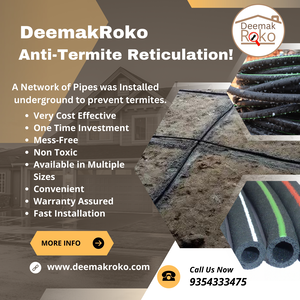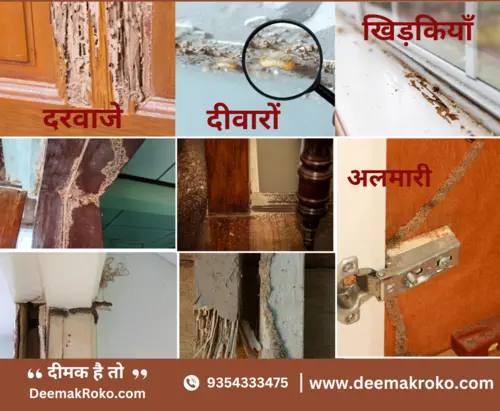Anti termite reticulation treatment is emerging as a sustainable and eco-friendly solution to the persistent and destructive problem of termites for homeowners. Traditional termite treatments have heavily relied on chemicals, posing risks to both the environment and human health. However, this innovative method offers a safer alternative. In this blog, we’ll explore what anti termite reticulation treatment entails, its benefits, and why it represents the future of termite control.

Understanding Termite Infestations
Termites are often called “silent destroyers” because they can cause significant damage to buildings without being detected until it’s too late. These insects feed on cellulose, which is found in wood and other plant materials, leading to structural damage in homes and buildings. Traditional methods of dealing with termites include soil treatments, bait stations, and direct wood treatments, all of which have their drawbacks.

The Limitations of Traditional Termite Treatments
Traditional termite treatments typically involve using chemical pesticides. These chemicals are often toxic and can pose risks to the environment, humans, and pets. Additionally, they may require frequent reapplication and can become less effective over time as termites develop resistance.
What is Anti Termite Reticulation Piping Treatment?
Anti termite reticulation piping treatment is a modern method of termite control. It involves the installation of a network of pipes around the perimeter of a building. These pipes are used to deliver termiticides directly into the soil, creating a continuous barrier. It protects the structure from termite invasion.
How Does It Work?
1. Installation: The reticulation system is installed during the construction phase of a building or as a retrofit to an existing structure. The pipes are laid around the foundation and other vulnerable areas.
2. Termiticide Application: Termiticides are pumped through the pipes, allowing for even distribution in the soil. This creates a protective barrier that termites cannot penetrate.
3. Refillable System: The system can be refilled with termiticides as needed, ensuring long-term protection without the need for frequent reapplication.
Benefits of Anti Termite Reticulation Piping Treatment
Anti termite reticulation piping treatment provides many advantages over traditional methods. It attracts people who want a more sustainable and effective way to handle termite problems. This system applies chemicals precisely, uses fewer chemicals, and lasts longer, making it a better choice for the environment and cost-effective in the long run. Homeowners and builders appreciate its ability to maintain continuous protection with minimal maintenance.
Eco-Friendly Approach
Unlike traditional treatments that require frequent reapplication, the reticulation system provides long-lasting protection. You can refill the pipes with termiticides as needed, maintaining a continuous barrier against termites. This method reduces the need for frequent and expensive treatments. It proves cost-effective in the long run.
Enhanced Safety
The precise application of termiticides through the reticulation system reduces the risk of exposure to humans and pets. This is particularly important in residential settings, where the safety of occupants is a top priority. This method provides a safer alternative to traditional treatments as it limits the spread of chemicals.
Targeted Application
The reticulation system targets the application of termiticides, delivering the chemicals precisely. This approach increases the treatment’s effectiveness and reduces waste. Traditional methods often distribute chemicals unevenly, creating gaps in protection and increasing the risk of termite infestation.
Installation Process of Anti Termite Reticulation Piping Treatment
Understanding the installation process of anti termite reticulation piping treatment is essential for homeowners and builders alike. This section will provide a step-by-step overview of how the system is installed and maintained.

Step-by-Step Installation
1. Site Assessment : The first step in the installation process is a thorough assessment of the site. This includes identifying potential entry points for termites and determining the best locations for the reticulation pipes.
2. Trenching : Trenches are dug around the perimeter of the building’s foundation. These trenches will house the reticulation pipes.
3. Pipe Laying : The reticulation pipes are laid in the trenches. These pipes are designed to be durable and resistant to damage from soil and other environmental factors.
4. Connection to Distribution Points : The pipes are connected to distribution points, which allow for the controlled release of termiticides into the soil.
5. Backfilling : Once the pipes are in place, the trenches are backfilled with soil. Care is taken to ensure that the pipes are not damaged during this process.
6. Initial Termiticide Application : After installation, termiticides are pumped through the pipes to create the initial barrier against termites
Maintenance and Refilling
The reticulation system requires periodic maintenance and refilling to ensure its effectiveness. This involves pumping additional termiticides into the pipes as needed, typically every few years. The exact frequency of refilling will depend on factors such as soil type, climate, and the severity of termite infestations in the area.

Comparing Anti Termite Reticulation Piping Treatment with Other Methods
To fully appreciate the benefits of anti termite reticulation piping treatment, it is helpful to compare it with other common termite control methods. This comparison will highlight the advantages of the reticulation system in terms of effectiveness, environmental impact, and cost.
Chemical Soil Treatments
Chemical soil treatments involve applying termiticides directly to the soil around a building’s foundation. While this method can be effective, it often requires large quantities of chemicals and can pose environmental and health risks.
– Effectiveness : Chemical soil treatments can be effective but may require frequent reapplication. The reticulation system, on the other hand, provides long-lasting protection with less frequent maintenance.
– Environmental Impact : Chemical soil treatments can lead to chemical runoff and contamination of soil and water. The reticulation system minimizes these risks by using precise application methods.
– Cost : While the initial cost of installing a reticulation system may be higher, the long-term savings from reduced reapplication and maintenance can make it a more cost-effective solution.
Bait Stations
Bait stations are another common method of termite control. These stations use bait that termites consume and then carry back to their colony, effectively eliminating the infestation.
– Effectiveness : Bait stations can be effective but may take longer to work compared to soil treatments and reticulation systems. The reticulation system provides immediate protection by creating a barrier that termites cannot cross.
– Environmental Impact : Bait stations typically use less chemical than soil treatments, but the reticulation system still offers a more targeted and environmentally friendly approach.
– Cost : Bait stations can be less expensive initially but may require more frequent monitoring and maintenance. The reticulation system, with its refillable pipes, offers a more sustainable and long-term solution.
Direct Wood Treatments
Direct wood treatments involve applying termiticides directly to the wood in a building. This method can be effective for treating localized infestations but may not provide comprehensive protection.
– Effectiveness : Direct wood treatments are effective for localized infestations but do not protect the entire structure. The reticulation system provides comprehensive protection by treating the soil around the building.
– Environmental Impact : Direct wood treatments can involve the use of harsh chemicals. The reticulation system minimizes chemical use and reduces environmental risks.
– Cost : Direct wood treatments can be costly if extensive areas need to be treated. The reticulation system offers a cost-effective alternative by providing long-lasting protection with fewer chemicals.
The Future of Termite Control
As awareness of environmental issues continues to grow, the demand for eco-friendly pest control solutions is increasing. Anti termite reticulation piping treatment represents the future of termite control because it offers a sustainable, effective, and long-lasting solution to a pervasive problem.
Environmental Benefits
The reticulation system offers significant environmental benefits. By applying chemicals precisely, it reduces the amount needed and minimizes the risk of contamination. This makes it an ideal choice for environmentally conscious homeowners and builders.
Technological Advancements
Advancements in technology are also driving the adoption of reticulation systems. New materials and improved installation techniques are making these systems more effective and easier to install. As technology continues to evolve, we can expect to see even more innovative solutions for termite control.
Increased Awareness
Increased awareness of the environmental and health risks associated with traditional termite treatments is leading more people to seek out alternative methods. The reticulation system offers a safer and more sustainable option that aligns with the growing demand for eco-friendly solutions.
Case Studies and Real-World Examples
To illustrate the effectiveness and benefits of anti termite reticulation piping treatment, let’s look at a real-world example and case study.
Case Study : Commercial Building of Marriot Hotels and Resort in Jaipur
A commercial building of Marriot Hotels and Resorts in Jaipur required a comprehensive termite control solution to protect its valuable assets. The building’s management chose the reticulation system for its effectiveness and eco-friendly approach. They installed the system during the construction phase, ensuring continuous protection from day one. Regular maintenance and refilling have kept the building termite-free, with minimal environmental impact.
Conclusion
In conclusion, anti termite reticulation piping treatment offers a revolutionary and eco-friendly solution for termite control. By providing precise application, long-lasting protection, and minimal environmental impact, it addresses the shortcomings of traditional termite treatments. This innovative approach not only safeguards homes and buildings from termites’ destructive nature but also promotes a healthier environment for all. As awareness of environmental issues grows and technology advances, anti termite reticulation piping treatment is set to become the standard for sustainable termite management. Homeowners and builders can look forward to a future where effective termite control aligns with environmental responsibility.
